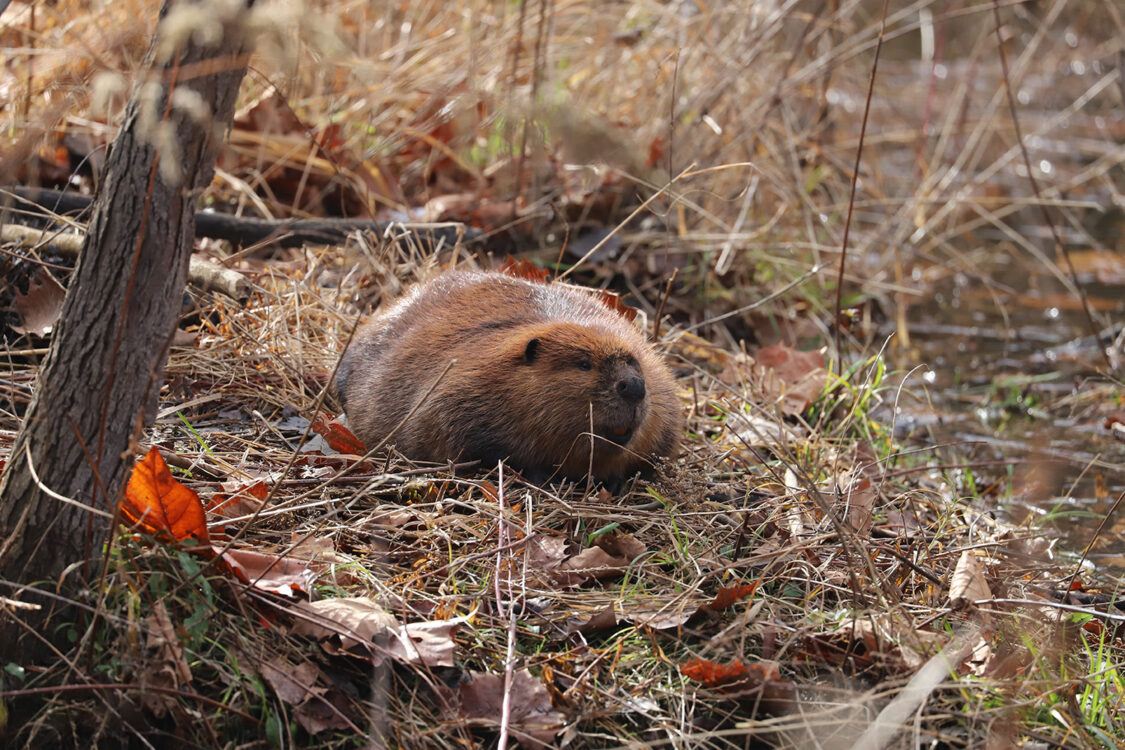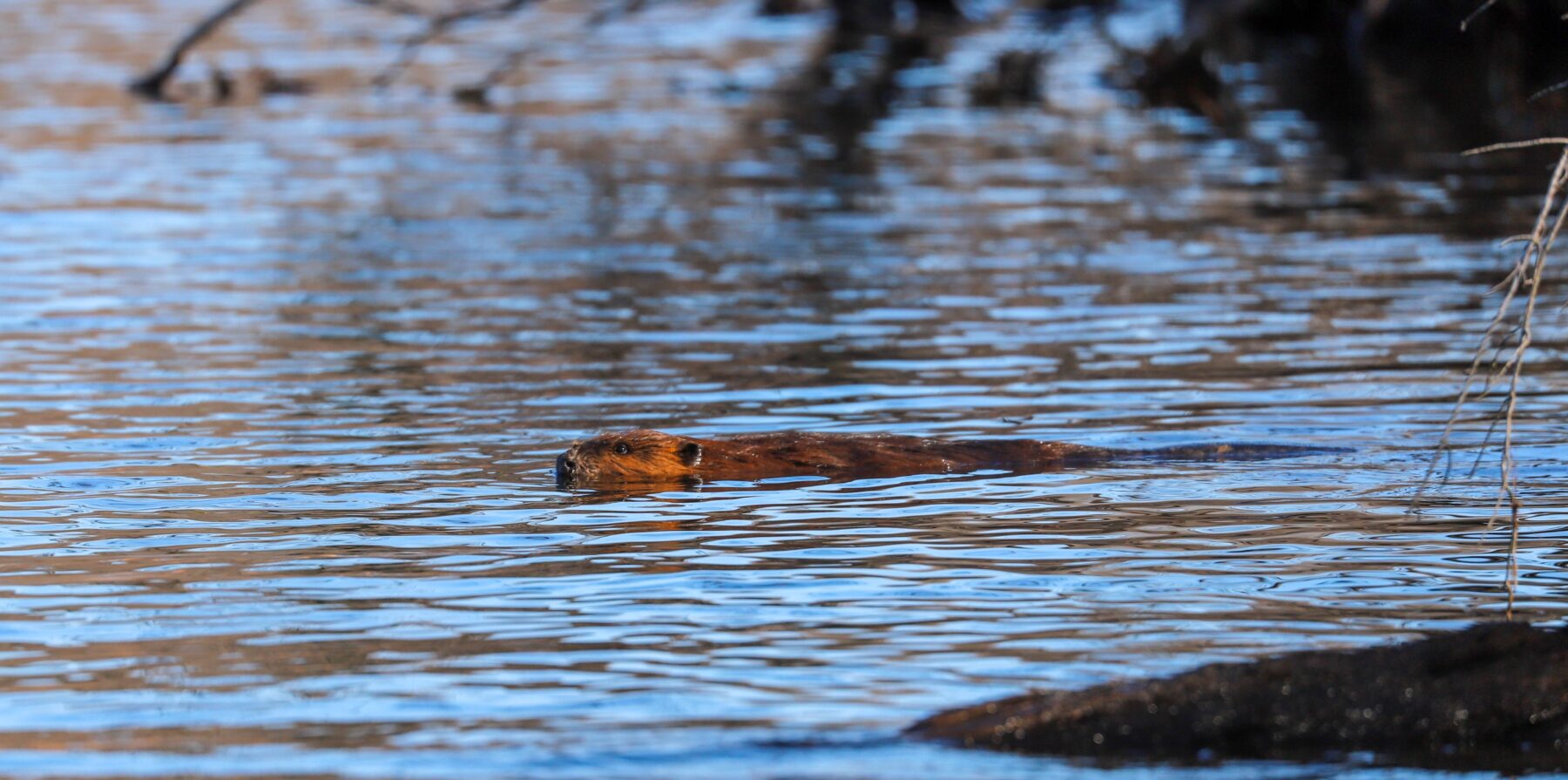Living with Beavers
The American Beaver (Castor canadensis) is the largest native rodent in North America, weighing between 35 and 60 pounds as an adult. When beavers are alarmed they slap their tails against the water to alert other beavers in the area, then dive into deep water for protection. Though excellent swimmers, they are slow and awkward on land which makes them vulnerable to predators. Beavers will always head for water when they feel threatened. They can reach speeds of up to 6 m.p.h. when swimming. Beavers use their tails as a rudder when swimming and to help them balance when standing upright. They do not use their tails for plastering mud onto their dams. Beavers are equipped with four large bright orange incisors. These front teeth grow continuously throughout their lifetime, so they must constantly chew to keep them short.
Beavers are vegetarians. During warm months of the year they eat aquatic plants, rhizomes of water lilies, sedges, grasses, ferns, algae, and the roots and sprouts of skunk cabbage. They also eat the leaves and twigs of trees. During fall and winter their main food source is the cambium layer of trees, which is the wood just under the bark. They spend a lot of time cutting and anchoring large piles of branches to the pond floor to store them for winter food. Some of their favorite trees include: willow, ash, cottonwood, alder, aspen, birch, and poplar. The beaver’s preference for ornamental and fruit trees is a major cause of conflict between beavers and homeowners.
Natural History
When Europeans first began to settle North America, beavers were plentiful, but the high demand for beaver pelts to supply the European fur trade in the 1800’s nearly caused their extinction. With the help of reintroduction and protection efforts they have made a successful comeback. Today, the biggest threat to beaver populations comes from human conflicts and habitat destruction. The urge to build dams comes from an instinctual reaction to the sound of running water. Beavers construct their dams from any available materials including: wood, mud, crop residue and stones. They usually build new dams in the spring and spend their time in the fall repairing old dams and storing food for winter. Beavers do not live in their dams; they build a separate lodge in the bank. They enter their lodge through tunnels that lead from underwater, up through the floor of the lodge. As water in the pond rises, they expand their lodge upward into a large mound of sticks and mud. A lodge will typically house a breeding pair of beavers and their offspring from the last two years.
Beavers, just like people, change their habitat to suit their needs. When beavers build a dam and change a portion of fast-moving stream into a pond, they not only create their own habitat but provide habitat for many other species and improve water quality. Beaver ponds are deep enough to prevent water from freezing to the bottom in winter. This provides important winter habitat for many species of fish, reptiles and amphibians. Beavers also help to protect water quality by slowing stream flows. When the water flow slows behind a dam, sediments suspended in the water have a chance to settle out, reducing the amount of sediment moving downstream and eventually entering the Chesapeake Bay.
Beavers create wetland habitat for herons, frogs, river otters, mink, muskrats, raccoons, amphibians, waterfowl, and many species of plants.

Reproduction
Males and females reach sexual maturity at about 21 months. Once mature, they will breed every year around February. Gestation lasts from 105 to 107 days. In May they will have a litter of three to five kits. The kits are born fully furred with open eyes. Two weeks after birth they are ready to make their first venture outside the lodge. They are weaned within two months but will not leave to seek out their own territory until they are two years old.
Issues and Impact Mitigation
Beavers have become so successful in some parts of Montgomery County that conflicts arise between human land uses and beaver activities. Despite the many positive effects of beaver on water quality and the creation of wetland habitat, beavers can become a nuisance. When beavers begin constructing dams near homes, they can flood low lying areas and damage backyard trees. Other problems include flooded roads, redirected stream flows, loss of large specimen trees, and higher water temperatures.
Preventing Tree Damage
If beavers in the area are damaging trees on your property, a simple fence 3 to 4 feet high made of heavy wire mesh can prevent damage. The fence should be approximately 8 to 10 inches from the plant and can be supported by driving metal rods into the ground to which the fence can be tied. A low sturdy fence, three feet high, can keep beavers out of an area entirely.
Preventing Flooding
A trickle leveler is a perforated pipe placed through a dam which allows water levels to be stabilized. The beavers continue to maintain their dam while the leveler prevents flooding of adjacent roads or yards.
Beavers in Parks

Wildlife management strives to reach a balance between wildlife and people. People may perceive beaver activity as beneficial, destructive,
or both. To some, beavers are just destroying trees. To others, they are creating wetland habitat, improving water quality, and opening areas of the forest to provide light and begin the process of forest regeneration.
Recognizing that one important function of park property is to provide wildlife habitat, current park management guidelines promote tolerance of beavers in parks while safeguarding private property. Beavers are an important part of Montgomery County’s native wildlife, and parks are one of the few places left where beavers can live. We must learn to live together.
When beavers damage trees on private property, recommendations are made to the landowner of ways to prevent this damage. Where flooding is the problem, methods are employed to restrict the flooding to park property. In most cases the cutting of trees on parkland is accepted as part of having beavers. Large trees are protected with fencing. Rare situations may require the removal of beavers or the use of other population control measures.
Where to See Beavers
The best way to see a beaver is to visit a dam site just before dark. Look for cut trees and tracks like those pictured here. Beavers will also create mounds of mud and secrete a sweet-smelling oil called castoreum onto the mounds to mark their territory. Castoreum is used as a fixative in some perfumes. You may also hear beavers chewing the inner bark of trees; this scraping sound can be heard from fifty yards away or more. Beavers occasionally make a murmuring noise and will hiss when angry.
Many people enjoy watching the social behaviors of beaver. Some of the county parks’ nature centers provide beaver programs for those who want to learn more about this fascinating animal. If you would like to see these interesting animals for yourself, there are active beaver lodges in several county parks including Black Hill Regional Park and Rock Creek Regional Park. The best times to see beavers in action are at dusk and dawn.
